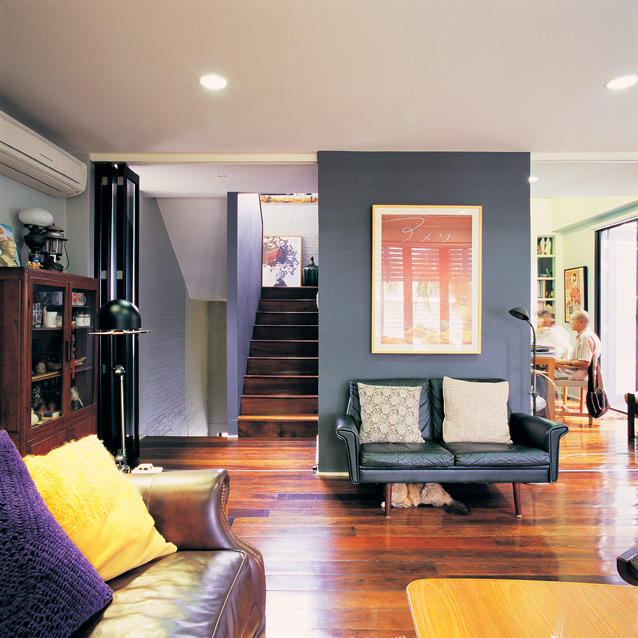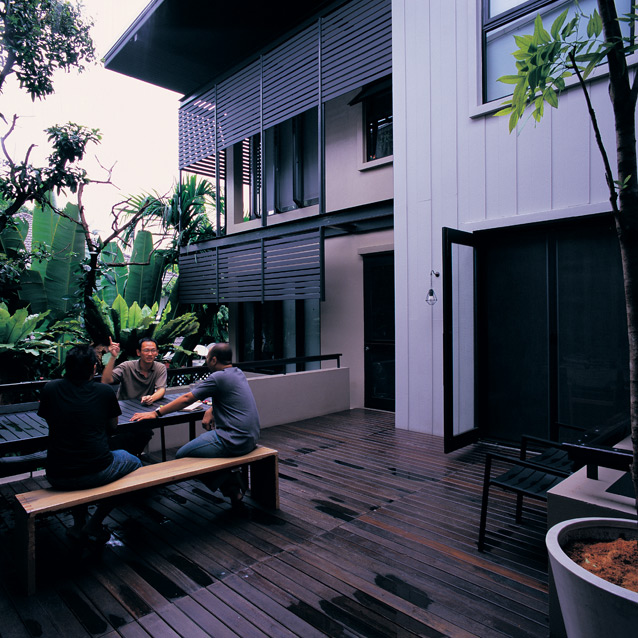
Family living entails a certain commitment to sharing of space. When designing a home for a family of four, the designer must ask to what extent can each family member’s particular needs be fulfilled, and to what extent should each inhabitant conform to collective living within the family.
These questions are hardly challenging when a house is simply a place inhabitants leave daily and return to rest. It does, however, become challenging when a house is required to perform multiple tasks, becoming a place for work, a place for business, a place for professional productions, and countless other possibilities.

Hidden in the labyrinthine road networks of Bangkok is a house for a family of four, whose daily activities revolve around their home. Pongsakorn Kitkajornpong, the architect, acquired the peaceful plot of land in the heart of Bangkok with a vision to create a home he could share with his extended family, as well as a space from which he could manage his own practice. Also living in the house is his retired father, who spends most of his time in and around the house, Pongsakorn’s brother, Bin Kitkajornpong, a renowned film director and his wife, Ploy Mallikamas, a well-known writer. Bin Kitkajornpong and his wife, like Pongsakorn Kitkajornpong, also use the house as both a domestic and professional domain.

In order for the design of a single house to accommodate such diverse domestic and professional needs, as well as take into account personal and aesthetic preferences, individual and collective dwelling criteria needed to be established before work on the design began. The first task of the architect was to understand not only the physical requirements but also socio-cultural specificities within the micro scale of the family. Only when such an understanding had been established could Kitkajornpong begin to translate the individual and collective needs into unique spatial and formal configuration.

The first solution, one that seems natural to the Thai way of living, was to envision a house ‘compound’ of multiple living quarters both separate and joined. Occupying the front is the area belonging to the architect and his father; at the back lies the home of his brother’s family. The two houses share the entrance stairs leading to the upper terrace that acts as both the unifying and segregating element – it is a point of entry that everyone shares before going their separate ways.
Elevating living areas from the ground has been a longstanding method used in Thailand to organise the hierarchy of diverse domestic activities. In this house, while multiple service areas are tucked underneath the terrace level, the main living and working areas of both ‘houses’ are raised on a platform joined by the extended terrace. The courtyard between the two houses performs similar task to the terrace, becoming either a place to join or a point to depart. Both the courtyard and the terrace are transitional elements that allow the two houses to coexist as one.

The interior makes use of a range of wide-and-high apertures that create a sense of openness that belies the fact that there is much spatial separation in the house. Indeed, some parts of the interior are decisively walled in to accommodate the diverse usages, but strategic positioning of openings creates a close relationship between interior activities and exterior spaces, making the walls less confining. It is as if the living box is pierced, allowing space to flow freely. The openings do not, however, necessarily frame specific views; instead one is aware of the landscape through an abundance of natural light and free-flowing air.

There are also open rooms and rooms with dematerialised walls. These spaces are not limited to the public or social parts of the house, and transparent walls that consist primarily of openings loosely demarcate some of the private spaces. In this way, the concept of private and enclosed is redefined and reinterpreted by the architect. The private space can be as open as the public, so long as it is placed in an appropriate location, orientation and sequence in relation to the surrounding spaces. These spaces in the house are defined architecturally by light, especially daylight, rather than articulated by walls.
Seen as one, the two parts of the house share a certain aesthetic, yet upon closer inspection, the spatial configuration of each ‘house’ is different. While the planning of the front part, occupied by the architect and his father, is relatively free, the back is more traditionally defined. This is a result of diverse requirements in terms of habits, rituals as and personal preferences. In the different parts of the house, activities have been translated into different spaces, creating diverse settings – but settings that perfectly reflect and suit the activities that occur within.

The language used in the finishing of the floors also affirms the specific nature of each setting. The different floor surfaces are an expression of care not just for building’s continuity but also for sequential interruptions from one usage to the next.
The house is neither one nor two, but a compound of relationships with developed vocabularies and concepts that demonstrate how settings that are both distant and distinct from one another can be interconnected. This does not mean that the diverse uses of the house by the four inhabitants need to be accommodated by the same material, nor does the house need to be spatially continuous, or given the same profile. Design, in this situation, depends on insight into situational similarities as well as differences. It has to establish the grounds for analogical relationships rather than concentrate entirely on shape or form. The floor plan creates alternatives that result in fluid yet well-defined spaces.

Both the land and the building are much more than aggregates of physical properties or something only to be enjoyed aesthetically. The project is not stylised in a sense that signifies authorship, but in a way intended to define and redefine ways of living in distinct and unique settings that are adaptable.

This house demonstrates architecture’s capacity to guide our lives, but at the same time shows ways in which our activities shape and reshape architectural configurations. Such a building may not be famous or considered exemplary of creative genius, but may, nevertheless, be indicative of what the true purpose of good architecture is. If such architecture is prosaic, it is also capable of standing silent witness to the stories of lives inscribed in its spaces. It is an architecture that does not intend to become a statement but a receptacle of life, a form that is never finished or final, but that is completed over time by the people that inhabit its spaces.
Text from issue #6 of Habitus Magazine
ARCHITECT / INTERIOR DESIGNER Pongsakorn Kitcachonpong
STRUCTURAL ENGINEER Panit Supatsiriluk
CONTRACTOR A N T Engineering
LANDSCAPE ARCHITECT Thanathep Tanvarawuttichai
PHOTOGRAPHER Pirak Anurakyawachon
SITE AREA 388 m2
BUILDING AREA 176 m2
TOTAL FLOOR AREA 333 m2
DESIGN 12 months
CONSTRUCTION 12 months

